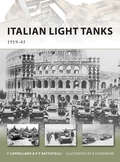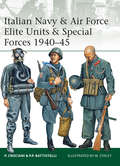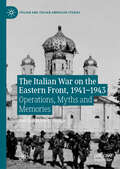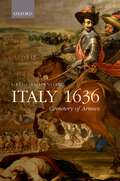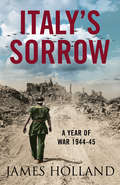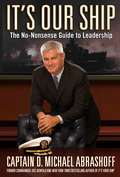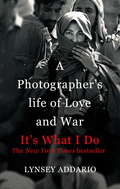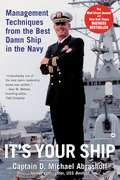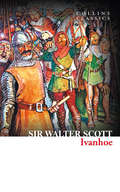- Table View
- List View
Italian Light Tanks: 1919–45 (New Vanguard #191)
by Pier Paolo Battistelli Richard Chasemore Filippo CappellanoThe Italian army, unlike those of the British and French, did not use tanks in combat during World War I and, by November 1918, only one training unit equipped with French Schneider and Renault tanks had been formed. Consequently, during the 1920s the Italian army had just one single tank type in its armoured inventory – the Fiat 3000. Only in 1927 was the first tank unit formed as a branch of the infantry and not as an independent organization, while the cavalry rejected the idea of both tanks and armoured cars and decided to stand by the use of horses for its mounted units. Between 1933 and March 1939, a further 2,724 CV 33 / L 3 tanks were built, 1,216 of which were exported all over the world. By the time Italy entered the war in June 1940, the army had 1,284 light tanks, 855 of which were in combat units, including three armoured divisions. Variants of the CV 33 / L 3 tanks included flame-throwers, bridge-layers, recovery vehicles, and a radio command tank. Some L 3 tanks were still in use in 1945, by both the Germans and the German-allied Italian units of the Repubblica Sociale.
Italian Navy & Air Force Elite Units & Special Forces 1940–45 (Elite #191)
by Pier Paolo Battistelli Piero Crociani Mr Mark StaceyThis volume assesses the formidable Special Forces fielded by Italy's navy and air force in World War II. Italian Navy Special Forces were particularly active and respected in the Mediterranean, where 10th Motor-Torpedo Boat Flotilla used frogmen, 'two-man torpedoes' and explosive ram-boats. The Italian Air Force formed a special commando unit, ADRA, before the 1943 surrender; it was tasked with attacking Allied airfields and communications in North Africa. Men from ADRA and Army paratroopers formed the new 'Folgore' Regiment, which also continued to fight alongside German forces until 1945. In both cases, the pro-Allied Italian forces also formed 'mirror' units to fight alongside US and British forces, including the Recce Squadron 'F'. Featuring rare photographs and specially commissioned artwork, this book tells the story of the little-known elite forces fielded by Italy's navy and air force in World War II, some of whose successors remain in service with today's Italian armed forces.
Italian Navy & Air Force Elite Units & Special Forces 1940–45 (Elite)
by Pier Paolo Battistelli Mark Stacey Piero CrocianiThis volume assesses the formidable Special Forces fielded by Italy's navy and air force in World War II. Italian Navy Special Forces were particularly active and respected in the Mediterranean, where 10th Motor-Torpedo Boat Flotilla used frogmen, 'two-man torpedoes' and explosive ram-boats. The Italian Air Force formed a special commando unit, ADRA, before the 1943 surrender; it was tasked with attacking Allied airfields and communications in North Africa. Men from ADRA and Army paratroopers formed the new 'Folgore' Regiment, which also continued to fight alongside German forces until 1945. In both cases, the pro-Allied Italian forces also formed 'mirror' units to fight alongside US and British forces, including the Recce Squadron 'F'. Featuring rare photographs and specially commissioned artwork, this book tells the story of the little-known elite forces fielded by Italy's navy and air force in World War II, some of whose successors remain in service with today's Italian armed forces.
Italian Partisans and British Forces in the Second World War: Working with the Enemy (Italian and Italian American Studies)
by Nicola CacciatoreThis book proposes a significant new interpretation of the relations between Italian partisans and British forces during the Italian campaign of 1943-1945. The core of the argument challenges many assumptions that are today still present both in Italian and in the Anglophone historiography on the subject. In current historiography, the debate is still ongoing as to whether the British were a hostile force to the Italian Resistance, trying to weaken it to better control it, or a genuine and committed ally. Instead of a clear-cut and artificial dichotomy between the 'Italians' and the 'British' this book posits the idea that lines were often blurred, and relations existed on a scale that included lots of grey and overlapping areas. Thanks to an original approach that examines the Italo-British interaction from a point of view as close as possible to the ‘action’, it proposes a new interpretation based on the way the British image was cast in Italy. Politics is left in the background in favour of an analysis of the concrete problems and difficulties that Italians and the British had to face when working together and how these processes influenced the image of Great Britain in Italy in the following decades. This produces a final interpretation that enriches current historiography and pushes forward our understanding of the relationship between Italian partisans and British forces.
The Italian Resistance: Fascists, Guerrillas and the Allies
by Tom BehanOne of the enduring myths about World War Two is that the Allies alone liberated occupied Europe. However, many countries had successful anti-fascist movements, and Italy's was one of the biggest and most politically radical. Yet it remains relatively unknown outside of its own homeland.*BR**BR*Tom Behan tells this inspiring history. Within Italy many plaques and streets commemorate the actions of the partisans - a movement from below that grew as Mussolini's dictatorship unravelled. Led by radical left forces, the Resistance trod a thin line between fighting their enemies at home and maintaining an uneasy working relationship with the Allies.*BR**BR*Through the use of unpublished archival material and interviews with surviving partisans, this is an inspiring story of liberation.
The Italian Resistance: Fascists, Guerrillas and the Allies
by Tom BehanOne of the enduring myths about World War Two is that the Allies alone liberated occupied Europe. However, many countries had successful anti-fascist movements, and Italy's was one of the biggest and most politically radical. Yet it remains relatively unknown outside of its own homeland.*BR**BR*Tom Behan tells this inspiring history. Within Italy many plaques and streets commemorate the actions of the partisans - a movement from below that grew as Mussolini's dictatorship unravelled. Led by radical left forces, the Resistance trod a thin line between fighting their enemies at home and maintaining an uneasy working relationship with the Allies.*BR**BR*Through the use of unpublished archival material and interviews with surviving partisans, this is an inspiring story of liberation.
Italian soldier in North Africa 1941–43 (Warrior)
by Steve Noon Pier Paolo Battistelli Piero CrocianiDespite the attention paid to the Afrikakorps over the years, it was the numerically far superior forces of the Italian Army that held the line and formed the bulk of the fighting power available to the Axis powers during the War in the Desert from 1941 through to 1943. Their performance has been unfairly criticised over the years – the best units of the Italian Army were equal to those of the British and Germans – but they suffered from a lack of mobility and poor equipment that made it impossible for them to meet mobile British forces on anywhere near equal terms. Despite this, the Italian Army went through many changes through the period, with the introduction of a variety of elite units – armoured, mechanised and parachute divisions that did much to restore the fighting reputation of the Italian soldier in the desert war. Their German allies belatedly acknowledged this with the redesignation of Panzerarmee Afrika as 1st Italian Army in February 1943. This title details recruitment, organisation and experience of the Italian forces in this theatre, casting new light on a force whose fighting power and capabilities have been unfairly ignored and maligned for too long.
Italian soldier in North Africa 1941–43 (Warrior #169)
by Steve Noon Pier Paolo Battistelli Piero CrocianiDespite the attention paid to the Afrikakorps over the years, it was the numerically far superior forces of the Italian Army that held the line and formed the bulk of the fighting power available to the Axis powers during the War in the Desert from 1941 through to 1943. Their performance has been unfairly criticised over the years – the best units of the Italian Army were equal to those of the British and Germans – but they suffered from a lack of mobility and poor equipment that made it impossible for them to meet mobile British forces on anywhere near equal terms. Despite this, the Italian Army went through many changes through the period, with the introduction of a variety of elite units – armoured, mechanised and parachute divisions that did much to restore the fighting reputation of the Italian soldier in the desert war. Their German allies belatedly acknowledged this with the redesignation of Panzerarmee Afrika as 1st Italian Army in February 1943. This title details recruitment, organisation and experience of the Italian forces in this theatre, casting new light on a force whose fighting power and capabilities have been unfairly ignored and maligned for too long.
The Italian War on the Eastern Front, 1941–1943: Operations, Myths and Memories (Italian and Italian American Studies)
by Bastian Matteo SciannaThe Italian Army’s participation in Hitler’s war against the Soviet Union has remained unrecognized and understudied. Bastian Matteo Scianna offers a wide-ranging, in-depth corrective. Mining Italian, German and Russian sources, he examines the history of the Italian campaign in the East between 1941 and 1943, as well as how the campaign was remembered and memorialized in the domestic and international arena during the Cold War. Linking operational military history with memory studies, this book revises our understanding of the Italian Army in the Second World War.
The Italian Wars 1494-1559: War, State and Society in Early Modern Europe
by Michael Edward Mallett Christine ShawThe Italian Wars of 1494-1559 had a major impact on the whole of Renaissance Europe. In this important text, Michael Mallett and Christine Shaw place the conflict within the political and economic context of the wars. Emphasising the gap between aims and strategies of the political masters and what their commanders and troops could actually accomplish on the ground, they analyse developments in military tactics and the tactical use of firearms and examine how Italians of all sectors of society reacted to the wars and the inevitable political and social change that they brought about. The history of Renaissance Italy is currently being radically rethought by historians. This book is a major contribution to this re-evaluation, and will be essential reading for all students of Renaissance and military history.
The Italian Wars 1494-1559: War, State and Society in Early Modern Europe
by Michael Edward Mallett Christine ShawThe Italian Wars of 1494-1559 had a major impact on the whole of Renaissance Europe. In this important text, Michael Mallett and Christine Shaw place the conflict within the political and economic context of the wars. Emphasising the gap between aims and strategies of the political masters and what their commanders and troops could actually accomplish on the ground, they analyse developments in military tactics and the tactical use of firearms and examine how Italians of all sectors of society reacted to the wars and the inevitable political and social change that they brought about. The history of Renaissance Italy is currently being radically rethought by historians. This book is a major contribution to this re-evaluation, and will be essential reading for all students of Renaissance and military history.
The Italian Wars 1494-1559: War, State and Society in Early Modern Europe (Modern Wars In Perspective)
by Christine Shaw Michael MallettThe Italian Wars 1494–1559 outlines the major impact that these wars had, not just on the history of Italy, but on the history of Europe as a whole. It provides the first detailed account of the entire course of the wars, covering all the campaigns and placing the military conflicts in their political, diplomatic, social and economic contexts. Throughout the book, new developments in military tactics, the composition of armies, the balance between infantry and cavalry, and the use of firearms are described and analysed. How Italians of all sectors of society reacted to the wars and the inevitable political and social change that they brought about is also examined, offering a view of the wars from a variety of perspectives. Fully updated and containing a range of maps as well as a brand-new chapter on propaganda and images of war, this second edition of The Italian Wars 1494–1559 is essential reading for all students of Renaissance and military history.
The Italian Wars 1494-1559: War, State and Society in Early Modern Europe (Modern Wars In Perspective)
by Christine Shaw Michael MallettThe Italian Wars 1494–1559 outlines the major impact that these wars had, not just on the history of Italy, but on the history of Europe as a whole. It provides the first detailed account of the entire course of the wars, covering all the campaigns and placing the military conflicts in their political, diplomatic, social and economic contexts. Throughout the book, new developments in military tactics, the composition of armies, the balance between infantry and cavalry, and the use of firearms are described and analysed. How Italians of all sectors of society reacted to the wars and the inevitable political and social change that they brought about is also examined, offering a view of the wars from a variety of perspectives. Fully updated and containing a range of maps as well as a brand-new chapter on propaganda and images of war, this second edition of The Italian Wars 1494–1559 is essential reading for all students of Renaissance and military history.
The Italian Wife: 'Breathtaking historical fiction' The Times
by Kate Furnivall*** THE Sunday Times TOP TEN BESTSELLING AUTHOR ***'Wonderful . . . hugely ambitious and atmospheric' Kate Mosse'Superb storytelling' Dinah Jefferies Discover a brilliant story of intrigue, romance and betrayal in 1930s Italy, from the internationally bestselling author of The Betrayal.*****Italy, 1932 -- Mussolini's Italy is growing from strength to strength, but at what cost?One bright autumn morning, architect Isabella Berotti sits at a café in the vibrant centre of Bellina, when a woman she's never met asks her to watch her ten-year-old daughter, just for a moment. Reluctantly, Isabella agrees -- and then watches in horror as the woman climbs to the top of the town's clock tower and steps over the edge.This tragic encounter draws vivid memories to the surface, forcing Isabella to probe deeper into the secrets of her own past as she tries to protect the young girl from the authorities. Together with charismatic photographer Roberto Falco, Isabella is about to discover that secrets run deeper, and are more dangerous, than either of them could have possibly imagined . . .From the glittering marble piazzas to the picturesque hillside villages and winding streets of Rome, The Italian Wife will take you on an breathtaking journey. Perfect for fans of Dinah Jefferies, Lucinda Riley and Rosanna Ley. Further praise for Kate Furnivall:'A thrilling plot ... Fast-paced with a sinister edge' Times'A thrilling, compelling read. Wonderful!' Lesley Pearse'Gripping . . . poignant, beautifully written ...will capture the reader to the last' Sun'Truly captivating' Elle'Perfect escapist reading' Marie Claire'An achingly beautiful epic' New Woman'A rollicking good read' Daily Telegraph
Italy 1636: Cemetery of Armies
by Gregory HanlonItaly 1636 is one of the most closely-researched and detailed books on the operation of early modern armies anywhere, and is explicitly inspired by neo-Darwinian thinking. Taking the French and Savoyard invasion of Spanish Lombardy in 1636 as its specific example, it begins with the recruitment of the soldiers, the care and feeding of the armies and their horses, the impact of the invasion on civilians in the path of their advance, and the manner in which generals conducted their campaign in response to the information at their disposal. The next section describes the unfolding of the long and stubborn battle of Tornavento, where Spanish, German, and Italian soldiers stormed the French in their entrenchments, detailing the tactics of both the infantry and the cavalry, and re-evaluating the effectiveness of Spanish methods in the 1630s. The account focuses on the motivations of soldiers to fight, and how they reacted to the stress of combat. Gregory Hanlon arrives at surprising conclusions on the conditions under which they were ready to kill their adversaries, and when they were content to intimidate them into retiring. The volume concludes by examining the penchant for looting of the soldiery in the aftermath of battle, the methods of treating wounded soldiers in the Milan hospital, the horrific consequences of hygienic breakdown in the French camp, and the strategic failure of the invasion in the aftermath of battle. This in turn underscores the surprising resilience of Spanish policies and Spanish arms in Europe. In describing with painstaking detail the invasion of 1636, Hanlon explores the universal features of human behaviour and psychology as they relate to violence and war.
Italy 1636: Cemetery of Armies
by Gregory HanlonItaly 1636 is one of the most closely-researched and detailed books on the operation of early modern armies anywhere, and is explicitly inspired by neo-Darwinian thinking. Taking the French and Savoyard invasion of Spanish Lombardy in 1636 as its specific example, it begins with the recruitment of the soldiers, the care and feeding of the armies and their horses, the impact of the invasion on civilians in the path of their advance, and the manner in which generals conducted their campaign in response to the information at their disposal. The next section describes the unfolding of the long and stubborn battle of Tornavento, where Spanish, German, and Italian soldiers stormed the French in their entrenchments, detailing the tactics of both the infantry and the cavalry, and re-evaluating the effectiveness of Spanish methods in the 1630s. The account focuses on the motivations of soldiers to fight, and how they reacted to the stress of combat. Gregory Hanlon arrives at surprising conclusions on the conditions under which they were ready to kill their adversaries, and when they were content to intimidate them into retiring. The volume concludes by examining the penchant for looting of the soldiery in the aftermath of battle, the methods of treating wounded soldiers in the Milan hospital, the horrific consequences of hygienic breakdown in the French camp, and the strategic failure of the invasion in the aftermath of battle. This in turn underscores the surprising resilience of Spanish policies and Spanish arms in Europe. In describing with painstaking detail the invasion of 1636, Hanlon explores the universal features of human behaviour and psychology as they relate to violence and war.
Italy and the Military: Cultural Perspectives from Unification to Contemporary Italy (Italian and Italian American Studies)
by Mattia RoveriThis book sheds new light on the role of the military in Italian society and culture during war and peacetime by bringing together a whole host of contributors across the interdisciplinary spectrum of Italian Studies. Divided into five thematic units, this volume examines the continuous and multifaceted impact of the military on modern and contemporary Italy. The Italian context offers a particularly fertile ground for studying the cultural impact of the military because the institution was used not only for defensive/offensive purposes, but also to unify the country and to spread ideas of socio-cultural and technological development across its diverse population.
Italy’s Sorrow: A Year Of War 1944 - 45
by James HollandToday Italy is a land of beauty and prosperity but in 1944-45 it had become a place of nightmares, a land of violence, war, and destruction. James Holland's ground-breaking account expertly documents the German advance to the stalemate of the Gothic line and a segment of Italian history that has been largely neglected.
It's All a Bit Heath Robinson: Re-inventing the First World War
by Lucinda Gosling in association with Mary Evans Picture LibraryWilliam Heath Robinson remains one of Britain’s best-loved illustrators and has embedded himself into English vernacular, inspiring the phrase ‘it’s all a bit Heath Robinson’ to describe any precarious or unnecessarily complex contraption. Born in London, he originally had ambitions to be a landscape painter, but would establish his artistic reputation as a book illustrator during the genre’s so-called golden age. It was his association with weekly illustrated magazine The Sketch that was to launch and cement his legacy as a humorous artist. Combining a distinctive draughtsmanship with a curious and ingenious mind, the advent of the First World War inspired Heath Robinson to dream up a series of increasingly outlandish and bizarre military inventions with which the opposing armies would try to outwit each other. From the kaiser’s campaigning car or a suggestion for an armoured bayonet curler, to post-war ‘unbullying’ of beef, his cartoons are a fantastically absurd take on wartime technology and home-front life. Sadly, his inventions were rejected by a (fictitious) ‘Inventions Board’, but the charm and eccentricity of his ideas was loved by the public and he remains to this day one of the finest exponents of humorous British art.
It's All About Treo: Life and War with the World's Bravest Dog
by Damien Lewis Dave HeyhoeThis is the incredible true story of the unbreakable bond forged between Treo, the world's most highly decorated dog, and his handler Sgt. Dave HeyhoeWhen Dave Heyhoe was sent to Afghanistan to help detect the Taliban's murderous roadside bombs, he knew he'd need a special dog by his side. Luckily for him, his closest pal Treo, a staggeringly brave ball of energy and mischief was with him every step of the way. The two friends had a miraculous understanding that helped them save countless lives but, as they embarked on a roller-coaster emotional ride, Dave realized he needed Treo more than he could ever have imagined. Tear-jerkingly sad one moment, laugh-out-loud hilarious the next, It's All About Treo is a moving and uplifting story that will melt the hearts of animal lovers everywhere.
It's Our Ship: The No-Nonsense Guide to Leadership
by Captain D. Michael AbrashoffCaptain D. Michael Abrashoff, legendary commander of the USS Benfold, continues in the same vein of his bestselling book IT'S YOUR SHIP with the knowledge he's gained from his speaking to and advising some of the top business minds in the world. The story of Captain Abrashoff and his command of USS Benfold has become legendary inside and outside the Navy. By governing his ship with his unique management techniques, Abrashoff turned the Benfold into a model of naval efficiency, with amazing cost savings, the highest gunnery score in the Pacific Fleet, and a highly motivated and top performing crew. In IT'S YOUR SHIP, he first demonstrated how to bring his successful management techniques from the ship to the boardroom. Now, in his newest book IT'S OUR SHIP, in the same rugged, can-do voice, Abrashoff will focus on the leadership, motivational, and management insights and tips that he has learned from his last six years of addressing business and corporate audiences. Abrashoff's timely advice will be eminently prescriptive, and will feature anecdotes and insights from leaders of businesses large and small and from public and non-profit sectors.
It's What I Do: A Photographer's Life of Love and War
by Lynsey AddarioWar photographer Lynsey Addario's memoir It's What I Do is the story of how the relentless pursuit of truth, in virtually every major theatre of war in the twenty-first century, has shaped her life. Lynsey Addario was just finding her way as a photographer when September 11th changed the world. One of the few photojournalists with experience in Afghanistan, when she is asked to return and cover the American invasion, she makes a decision - not to stay home, not to lead a quiet or predictable life, but to set out across the world, face the chaos of crisis, and make a name for herself. Addario travels with purpose and bravery, photographing the Afghan people before and after the Taliban reign, the civilian casualties and misunderstood insurgents of the Iraq War, as well as the burned villages and countless dead in Darfur. She exposes a culture of violence against women in the Congo and tells the riveting story of her headline-making kidnapping by pro-Qaddafi forces in the Libyan civil war.As a woman photojournalist Addario is determined to be taken as seriously as her male peers. She fights her way into a boys' club of a profession; and once there, rather than choose between her personal life and her career, Addario learns to strike a necessary balance. Watching uprisings unfold and people fight to the death for their freedom, Addario understands she is documenting not only news but also the fate of society. It's What I Do is more than just a snapshot of life on the front lines; it bears witness to the human cost of war.
It’s Your Ship: Management Techniques From The Best Damn Ship In The Navy
by Captain D. Michael AbrashoffThe story of Captain D. Michael Abrashoff and his command of USS Benfold has become legendary inside and outside the Navy. Now Abrashoff offers this fascinating tale of top-down change for anyone trying to navigate today's uncertain business seas. When Captain Abrashoff took over as commander of the Benfold, a ship armed with every cutting-edge system available, it was like a business that had all the latest technology but only some of the productivity. Knowing that responsibility for improving performance rested with him, he realized he had to improve his own leadership skills before he could improve his ship. Within months he created a crew of confident and inspired problem-solvers eager to take the initiative and take responsibility for their actions. The slogan on board became "It's your ship," and Benfold was soon recognized far and wide as a model of naval efficiency. How did Abrashoff do it? Against the backdrop of today's United States Navy - Benfold was a key player in our Persian Gulf fleet - Abrashoff shares his secrets of successful management including: See the ship through the eyes of the crew: By soliciting a sailor's suggestions, Abrashoff drastically reduced tedious chores that provided little additional value. Communicate, communicate, communicate: The more Abrashoff communicated the plan, the better the crew's performance. His crew would eventually call him "Megaphone Mike", since they heard from him so often. Create discipline by focusing on purpose: Discipline skyrocketed when Abrashoff's crew believed that what they were doing was important. Listen aggressively: After learning that many sailors wanted to use the GI Bill, Abrashoff brought a test official aboard the ship-and held the SATs forty miles off the Iraqi coast. From achieving amazing cost savings to winning the highest gunnery score in the Pacific Fleet, Captain Abrashoff's extraordinary campaign sent shock waves through the U.S. Navy. It can help you change the course of your ship, no matter where your business battles are fought.
Ivanhoe: Complete, With Notes And Glossary (Collins Classics)
by Sir Walter ScottHarperCollins is proud to present its incredible range of best-loved, essential classics.
